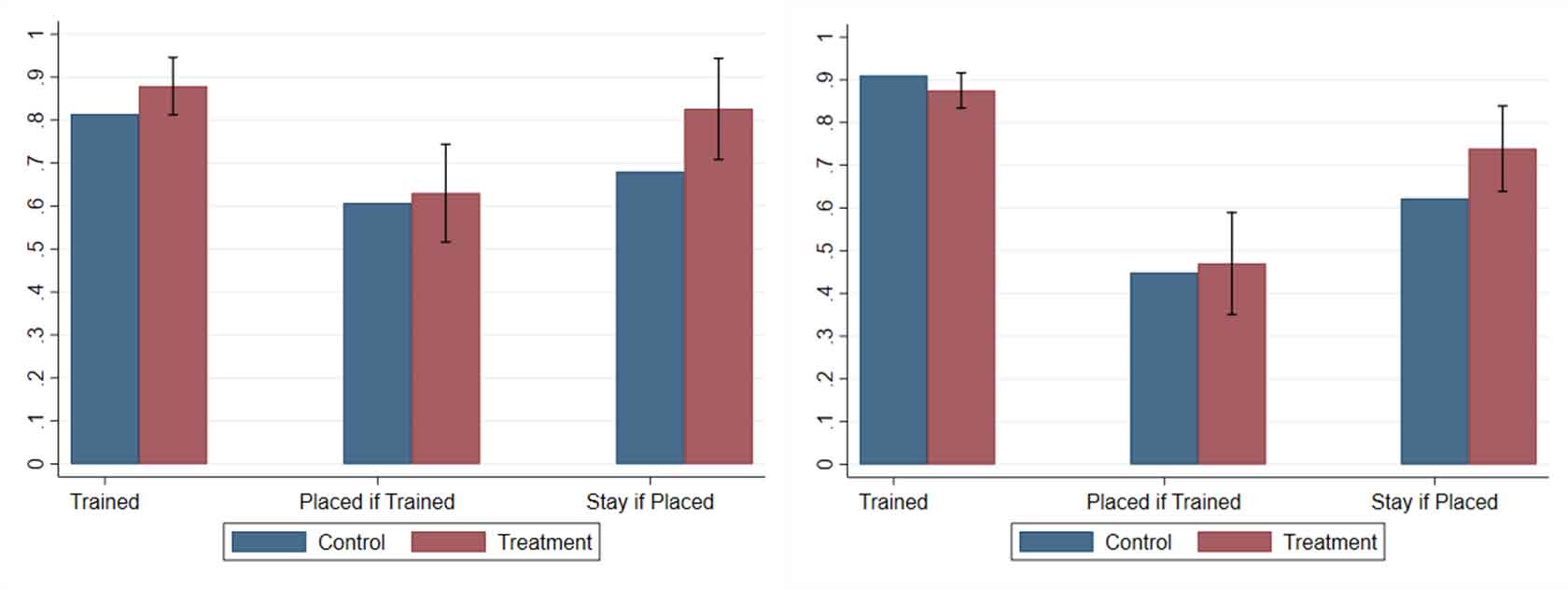Launched in 2014 by the central government, Deen Dayal Upadhyaya Grameen Kaushalya Yojana seeks to provide skills-based training to rural, marginalised youth, and to place them in salaried jobs. Based on an experiment conducted in Bihar and Jharkhand, this article shows that providing detailed information about the programme and prospective jobs to the trainees, helps align their expectations with realities, and enhances job retention.
A vast majority of the youth in India are engaged in informal jobs, or employed in small unorganised enterprises (Mehrotra 2020). To promote formal salaried employment, in 2014, the Ministry of Rural Development of the Government of India, launched a national skills-based training programme – Deen Dayal Upadhyaya Grameen Kaushalya Yojana (DDU-GKY). The programme provides short-term residential training to disadvantaged rural youth between 15 and 35. Unlike other training programmes, DDU-GKY ensures that every trainee will be offered a placement job. Despite this, according to official data, about one million of youth were trained since 2014, but only about 55% of them were placed.
Initial discussions with training providers and state officials in charge of implementation in Bihar and Jharkhand highlighted their concern regarding drop-out from training (12% according to administrative records), low placement rates (about 50%), and low retention in the placement jobs (about 60% after three months). One possible reason mentioned is that many of the trainees were unaware of the details regarding the placement jobs. There also seems to be some misalignment between trainee’s expectations and the actual economic returns to training, which was also highlighted by recent research from Banerjee and Chiplunkar (2020). This forms the basis of our research.
The experiment
In a project funded by the IGC, the Economic and Social Research Council (ESRC) and the University of Warwick, we set up a randomised experiment in the states of Bihar and Jharkhand, two of India’s poorest states, to investigate whether providing detailed information about post-training jobs could improve placement outcomes for DDUGKY trainees (Chakravorty et al. 2020). The experiment includes 86 training batches (about 2,500 trainees)1, of which 42 were randomly allocated to the treatment group and the remaining 44 to the control group2.
The intervention administered to the treatment group consisted of two classroom information sessions about the DDU-GKY programme (number of days of training, modules taught, facilities provided during and after the training), and prospective job opportunities (job location, compensation package, working hours). The sessions ended on a motivational note about the possibilities of on-the-job career progression. The first session happened at the beginning of the training, the second before placement.
Our expectation from this intervention is that trainees who continue with the training would be better informed about the placement jobs, and therefore less likely to be negatively surprised, and more likely to stay. Candidates who realise early on that the placement jobs do not match their expectations, may decide to drop out of the training, and be replaced by candidates who may need the programme more than they do. Hence, the intervention would improve the targetting of resources on trainees who really value them.
Findings
To evaluate the effect of the intervention, we conducted four rounds of surveys with 2,488 trainees between December 2018 and May 2020. The average age is 20 years, and 52% of trainees are female. In Jharkhand 46% of the trainees are Scheduled Tribes, in Bihar 33% are Scheduled Castes, and around 79% of the trainees are from BPL (below poverty line) households, which suggests that DDU-GKY does fulfil its mission of targetting disadvantaged youth. Most trainees did not have any job before joining the training.
We find that overall, the intervention did not change the likelihood of training being completed, nor the likelihood of being placed in a job (Figure 1). However, trainees in the treatment group were 17% more likely to stay in the jobs in which they were placed, for at least until five months after training completion. This suggests that a low-cost intervention can achieve substantial improvements in placement outcomes. These average effects mask important heterogeneity by level of education and gender3.
Figure 1. Impact of the intervention on training and placement outcomes
We first consider heterogeneity by level of education. The intervention increases the probability of training completion among less educated youth (less than grade 12) by 7% (Figure 2a). In contrast, the intervention decreases the probability of training completion among more educated youth (grade 12 and above) by 50% (Figure 2b). This suggests that more educated youth have better outside options, and hence, when they learn about the details of the placement jobs, they are disappointed and drop out of the training. Thus, the intervention improves the targetting of DDU-GKY towards the less educated youth.
Figure 2. Impact of the intervention by level of education: less than grade 12 (left; 2a) and grade 12 and above (right; 2b)
Turning to heterogeneity by gender, we find that the treatment has no effect on women (Figure 3a). In contrast, the effect of treatment on men is large (Figure 3b) – the intervention increases the placement probability by 33% and the probability of job retention for at least five months after training by 46% in men. These results suggest that the mismatch between expectations and placement jobs may be more important for male than female trainees – women have fewer alternative employment opportunities, and have very low dropout, higher placement, and higher retention to start with.
Figure 3. Impact of the intervention, by gender: women (left; 3a) and men (right; 3b)
Conclusion
We conclude that, providing detailed information about post-training job opportunities can help to align trainees’ expectations with realistic earnings, and be more effective in increasing job retention. This finding is notable, given that the cost of delivering this kind of intervention is low. Implementing a similar intervention in a larger scale has the potential to enable training providers to better meet the goals of the DDU-GKY.
The authors would like to thank BRLPS (Bihar Rural Livelihoods Promotion Society), JSLPS (Jharkhand State Livelihood Promotion Society) and the Ministry of Rural Development for collaboration on the research. They would also like to thank Mr Sanjay Kumar (BRLPS) and Mr Abhinav Bakshi (JSLPS) for their extensive cooperation during the project implementation
I4I is now on Telegram. Please click here (@Ideas4India) to subscribe to our channel for quick updates on our content.
Notes:
- A batch is a group of students who enrol, have classes, and graduate together.
- Randomisation ensures that the control group is comparable to the treatment group, and that the only difference between the two is that the treatment group received the information intervention. The randomisation design ensured equal numbers of treatment and control in each state and sector of training.
- We investigate heterogeneity by caste and find no statistically significant difference
Further Reading
- Banerjee A and G Chiplunkar (2020), ‘How important are matching frictions in the labor market? Experimental & non-experimental evidence from a large Indian firm’, Unpublished manuscript.
- Chakravorty, B, W Arulampalam, C Imbert, and R Rathelot (2021), 'Improving skills in Bihar: How to reduce drop-out rates from training programmes?', Working paper.
- Mehrotra (2020), ‘Informal Employment Trends in the Indian Economy: Persistent informality, but growing positive development’, ILO Employment Working Paper 254.




 06 May, 2021
06 May, 2021 










Comments will be held for moderation. Your contact information will not be made public.